Creating an Inspiring and Functional Office Space: A Comprehensive Guide to Office Interior Design.

Table of Contents
Office interior design plays a pivotal role in shaping the functionality and aesthetics of a workspace.
It goes beyond mere decoration; it’s about crafting an environment that not only looks appealing but also optimizes productivity and enhances employee well-being.
In this article, we will delve into the essential aspects of office interior design, emphasizing the profound impact it has on the workplace.
A well-designed office space isn’t just a matter of style; it’s a strategic asset that can significantly influence the way employees work, collaborate, and perform.
The careful selection of colors, furniture, layout, lighting, and overall ambiance can create an atmosphere that fosters creativity, concentration, and job satisfaction.
Recognizing the importance of office interior design is the first step toward creating a workspace that not only impresses visitors but also empowers your team to excel.
I. Understanding Your Office’s Purpose
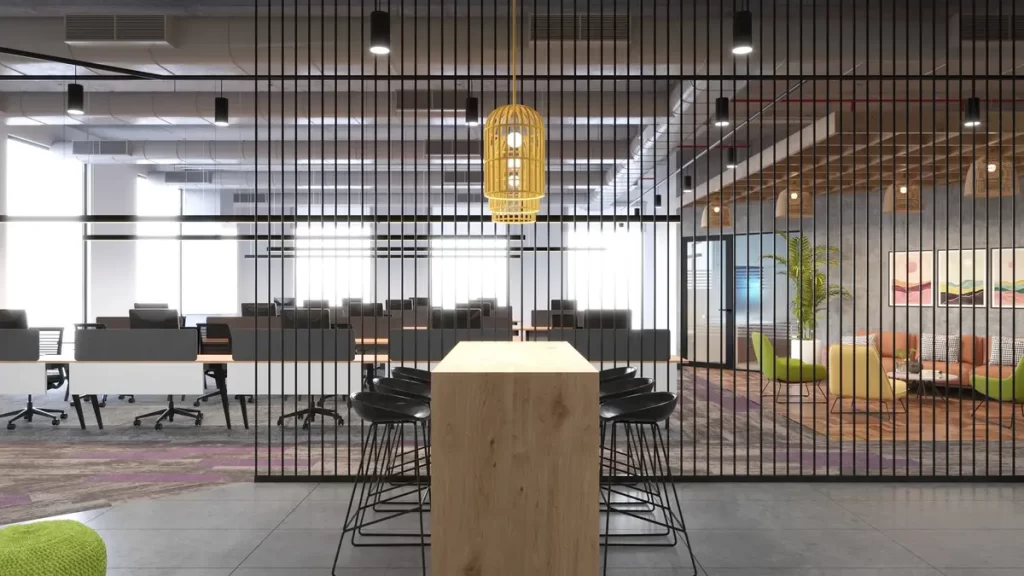
To embark on a successful office interior design journey, you must begin by clearly defining the purpose and objectives of your office space.
The design of your workspace should align with the specific functions it needs to serve.
Is your office a creative hub where brainstorming and innovation are paramount, or is it a corporate setting that requires a formal and professional ambiance?
The answer to this question is pivotal because it will guide every decision you make in the design process.
The purpose of your office space will influence everything from the choice of furniture to the layout, colors, and even the choice of technology integration.
Understanding the unique needs and goals of your office will allow you to tailor the design to suit your team’s work style, which, in turn, will have a profound impact on productivity and overall employee well-being.
In the world of office interior design, a one-size-fits-all approach is rarely effective, so it’s essential to customize the design to your specific objectives.
II. Space Planning and Layout
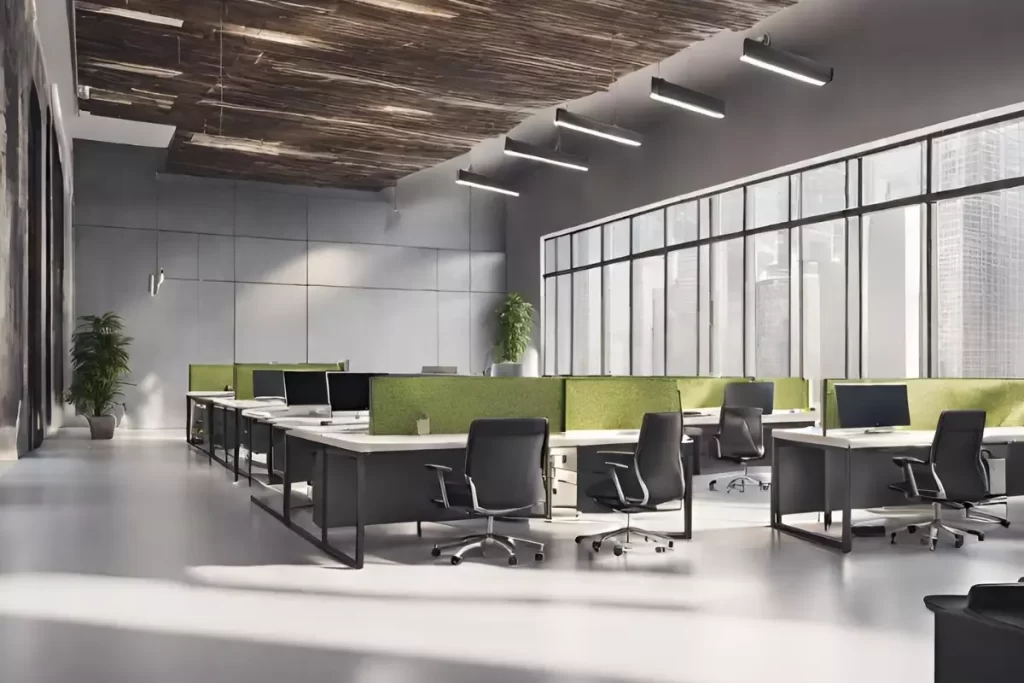
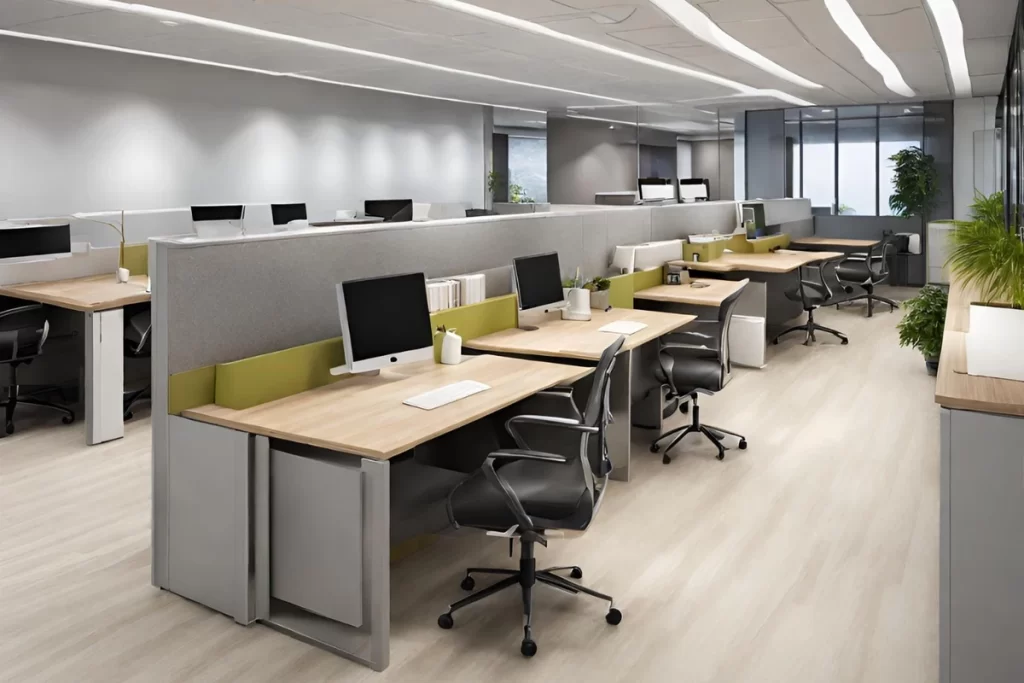
Efficient space planning is the backbone of successful office interior design.
It’s the art of optimizing the available space to meet your specific needs while creating an environment that is both functional and visually appealing.
Let’s explore the significance of efficient space planning and delve into various office design styles, including open-plan layouts, cubicles, and private offices, all while considering the crucial elements of flow and communication.
The Importance of Efficient Space Planning

Effective space planning is a cornerstone of office interior design, and here’s why:
Maximizing Space Utilization: Efficient space planning ensures that every square foot is used optimally.
It allows you to make the most of your available area, avoiding wastage and clutter.
Enhancing Productivity: A well-planned workspace can streamline daily operations, reducing the time and effort required to complete tasks.
It minimizes the need to navigate obstacles and distractions.
Promoting Collaboration: A carefully planned layout can foster collaboration by strategically positioning workstations, meeting areas, and communal spaces.
This facilitates communication and teamwork.
Creating a Comfortable Environment: Properly planned spaces take into account the comfort of employees.
Factors like adequate personal space, ergonomic furniture, and good lighting are all part of a well-planned office interior design.
Understanding Different Office Design Styles

Office interior design comes in various styles, each catering to specific needs and preferences.
These styles can include:
Open-Plan Layouts:

Characterized by a lack of dividing walls, open-plan layouts promote interaction and collaboration.
They are ideal for organizations focused on teamwork and communication.
However, they should be thoughtfully designed to provide a balance between communal and individual workspaces.
Cubicles:
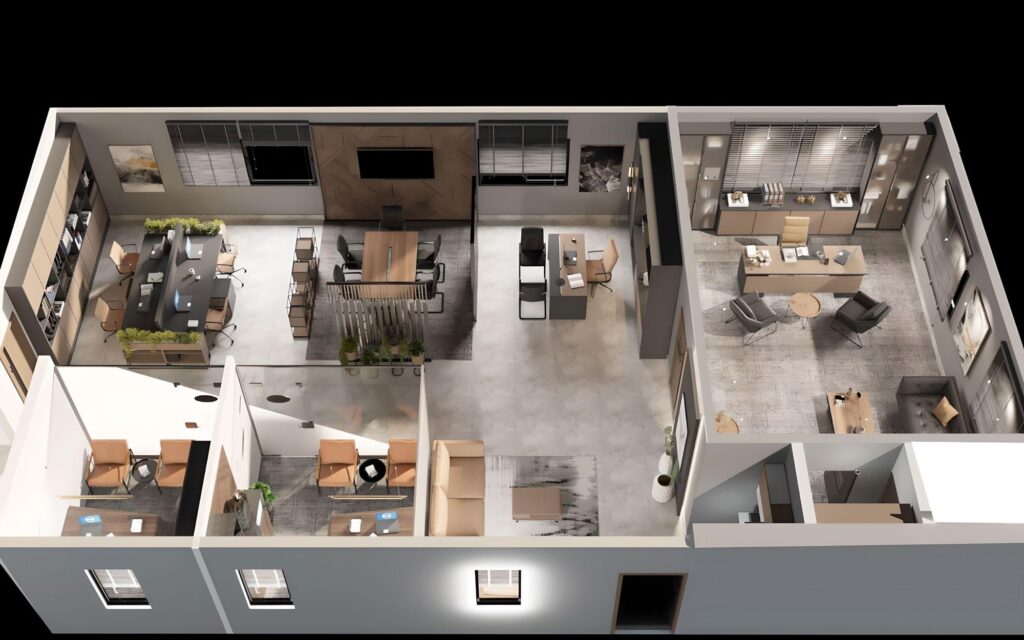
Cubicles offer a compromise between open spaces and private offices.
They provide employees with a sense of personal space while still allowing for easy communication.
Considered more traditional, cubicles can be customized to align with your brand and culture.
Private Offices:

Private offices are reserved for higher-level staff or individuals who require a quieter and more private workspace.
While they may limit interaction, private offices are often essential for tasks that demand intense concentration and confidentiality.
Considerations for Flow of People and Communication

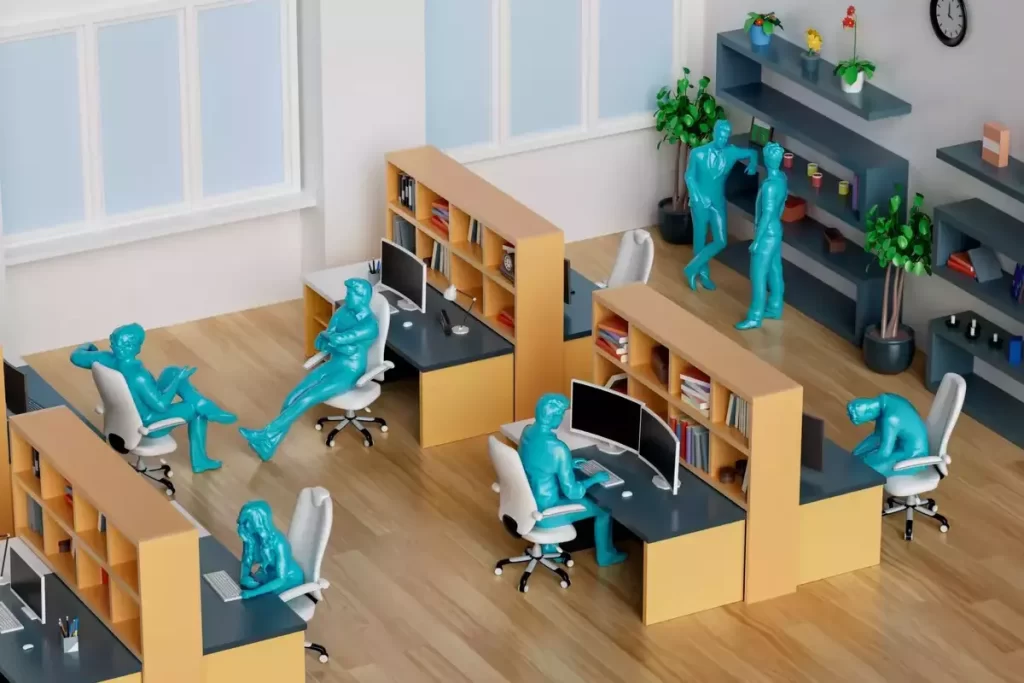
In office interior design, the flow of people and communication is a critical element.
Consider the following:
Traffic Patterns: Efficient space planning should account for how people move throughout the office.
Ensure that pathways are clear, minimizing congestion and bottlenecks.
Proximity: Arrange workstations and collaborative areas in a way that minimizes the distance employees need to travel to interact with colleagues or access resources.
Noise Control: Consider the acoustics of the space, especially in open-plan layouts.
Incorporate sound-absorbing materials and design elements to minimize distractions and maintain a comfortable noise level.
Visual Connections: Use the layout to create visual connections between different areas, fostering a sense of unity and shared purpose.
Incorporating these elements into your office interior design will help create a workspace that not only looks good but also functions efficiently and supports the goals and work styles of your team.
III. Ergonomic Design and Furniture Selection

Creating a comfortable and functional workspace is a cornerstone of effective office interior design.
Ergonomic design and the careful selection of furniture play a vital role in this process.
Significance of Ergonomic Furniture

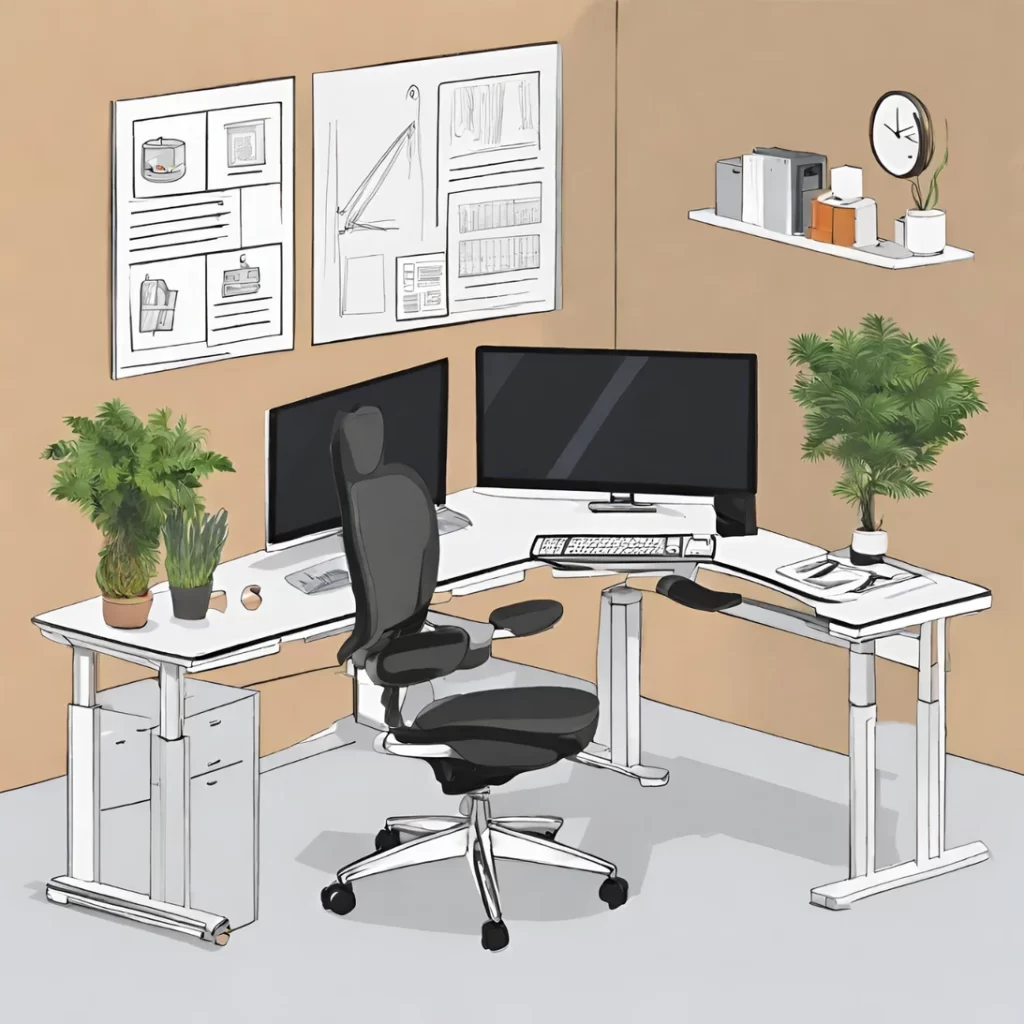
Ergonomics is not just a buzzword but a critical aspect of office interior design.
Ergonomic furniture is designed to enhance employee well-being, reduce the risk of musculoskeletal problems, and boost productivity for these key reasons:
Health and Comfort: Ergonomic chairs and desks support natural body posture, reducing discomfort during extended work hours, and resulting in happier, healthier employees.
Productivity: Comfortable employees can focus more effectively on tasks, minimizing distractions and helping maintain concentration.
Long-Term Savings: Investing in ergonomic furniture can lead to cost savings by reducing workplace injuries and absenteeism related to discomfort.
Tips for Furniture Selection

Selecting the right furniture is crucial for successful office interior design.
Here are key tips:
Desks: Opt for desks with ample space and consider adjustable height options for sit-stand flexibility.
Chairs: Choose ergonomic chairs with lumbar support and adjustable features.
Test for comfort before buying.
Accessories: Complement furniture with accessories like monitor stands, keyboard trays, and cable management for a tidy workspace.
Incorporate adjustability and personalization:
Height Adjustability: Ensure desks and chairs can be adjusted to accommodate diverse body types and work preferences.
Customization: Encourage employees to personalize their workspace with items like indoor plants, artwork, or personal touches to enhance comfort and motivation.
Incorporating Branding into Your Office Interior Design

Branding isn’t limited to logos and marketing materials; it can also be a central element of your office interior design.
Here’s how to infuse branding into your workspace:
Color Palette: Use your company’s brand colors in the office design, creating a visual connection between the physical space and your brand identity.
Logos and Artwork: Incorporate your company’s logo and artwork that reflects your brand’s story, values, and mission into the office’s décor.
Brand Messaging: Share your brand’s messaging through wall decals, posters, or digital displays to reinforce your corporate culture.
Incorporating branding into your office design not only strengthens your company’s identity but also creates a unique and cohesive environment that resonates with both employees and visitors.
It’s a powerful way to communicate your brand’s story and values through your office interior design.
IV. Color Psychology and Lighting in Office Interior Design
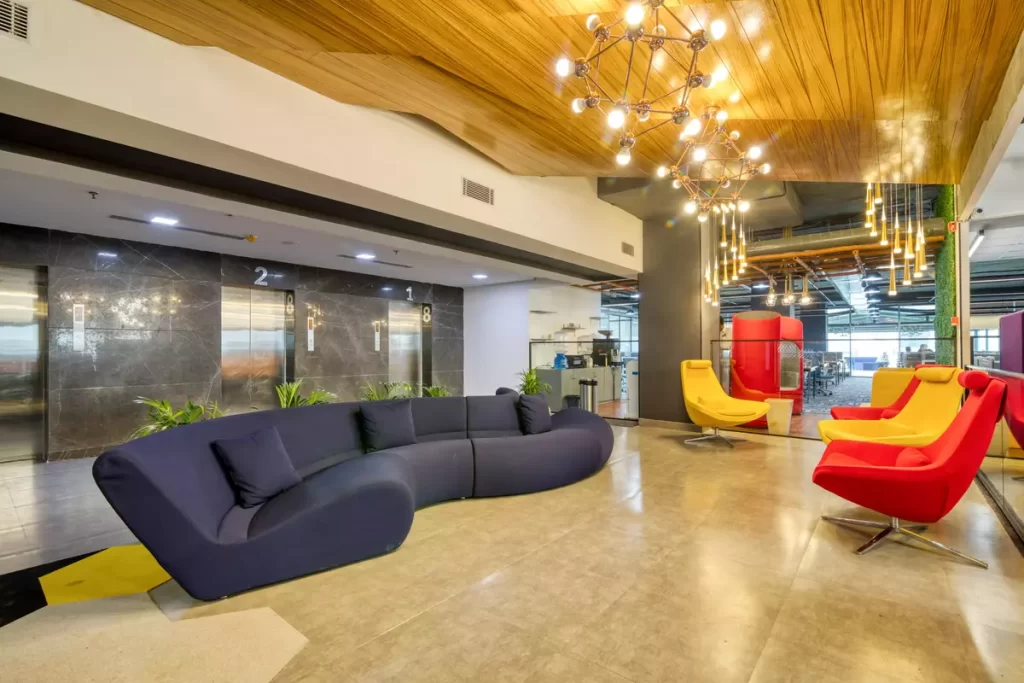
The choice of colors and the quality of lighting in your office interior design can significantly influence the mood and productivity of your workspace.
Let’s uncover the essential aspects of color psychology and lighting selection:
Impact of Colors on Mood and Productivity

Color Associations: Colors evoke emotional responses.
For instance, blues and greens are often associated with calmness, while reds and yellows can energize and inspire creativity.
Understanding these associations is key to creating the desired atmosphere.
Mood Enhancement: The right color scheme can enhance the overall mood in the office.
Cool colors like blue and green promote relaxation and concentration, while warm colors like orange and yellow can foster energy and enthusiasm.
Productivity Boost: Well-chosen colors can boost productivity.
For tasks that require focus and attention to detail, consider blues and muted tones. For creative brainstorming sessions, opt for stimulating colors like orange or red.
Choosing Appropriate Color Schemes

Nature-Inspired Palettes: Nature offers an abundance of harmonious color schemes.
Consider using earthy tones, such as greens, browns, and blues, to create a soothing and balanced atmosphere.
Branding Alignment: Align your color choices with your brand’s identity and values.
Consistency in branding creates a strong and memorable image.
Balance and Contrast: Avoid overwhelming spaces with overly bold colors.
Instead, use vibrant colors sparingly and balance them with neutral tones to create a visually appealing environment.
Significance of Natural and Artificial Lighting

Natural Light: Maximizing natural light is crucial.
It not only reduces the need for artificial lighting but also connects employees with the outside world.
Place workstations near windows to take advantage of natural daylight.
Artificial Lighting: Well-designed artificial lighting complements natural light.
Use task lighting for work areas, ambient lighting for general illumination, and accent lighting to highlight architectural features or artwork.
Color Rendering: Consider the Color Rendering Index (CRI) of light sources.
Higher CRI bulbs provide more accurate color representation, which is essential for tasks that rely on color accuracy, such as graphic design or fashion.
It ensures that colors appear as they would under natural daylight, reducing the risk of color distortion.
In conclusion, the careful selection of colors and lighting in your office interior design can create an environment that supports specific moods and tasks.
Utilize color psychology, choose appropriate color schemes, and make the most of natural and artificial lighting to enhance the overall effectiveness and well-being of your workspace.
V. Incorporating Technology


In today’s modern offices, technology is not just an accessory; it’s an integral component of productivity and efficiency.
Addressing the integration of technology is a key aspect of office interior design.
Here’s why it matters:
Integration of Technology:
Seamless Workflows: Technology integration streamlines workflows, allowing employees to work more efficiently, collaborate seamlessly, and easily access information.
Enhanced Communication: Modern offices rely on various communication tools and devices.
Well-planned integration ensures that devices like video conferencing equipment and communication platforms work harmoniously.
Cable Management and Power Access:
Organized Space: Effective cable management keeps the workspace clutter-free and reduces the risk of tripping hazards.
Cable trays, grommets, and under-desk cable solutions help maintain a clean and organized appearance.
Accessible Power: Access to power outlets is critical.
Ensure that workstations have easy access to power sources to accommodate the myriad of devices used in the modern office, from laptops and smartphones to monitors and chargers.
VI. Sustainability and Green Design

Sustainable design in office interior design isn’t just an environmental trend; it’s a strategic choice that brings tangible benefits:
Benefits of Sustainable Design:

Environmental Impact: Reducing a workspace’s environmental footprint through sustainable design choices results in lower resource consumption and less waste, contributing to a healthier planet.
Improved Indoor Air Quality: Using eco-friendly materials and products can enhance indoor air quality, creating a healthier and more productive work environment for employees.
Eco-Friendly Materials and Energy-Efficient Solutions:

Material Selection: Opt for materials with recycled content, low VOC emissions, and environmentally responsible sourcing.
Sustainable options include bamboo, reclaimed wood, and recycled metal.
Energy Efficiency: Incorporate energy-efficient lighting, heating, ventilation, and air conditioning systems.
Consider occupancy sensors and natural lighting to minimize energy consumption.
Waste Reduction: Minimize waste by choosing materials that can be recycled or repurposed and by implementing responsible construction practices.
Prioritizing sustainability and green design in office interior design aligns with a broader ecological responsibility, enhances employee well-being, and can even result in long-term operational cost savings.
It’s a choice that not only benefits the environment but also your business and its occupants.
VII. Creating Collaborative Areas
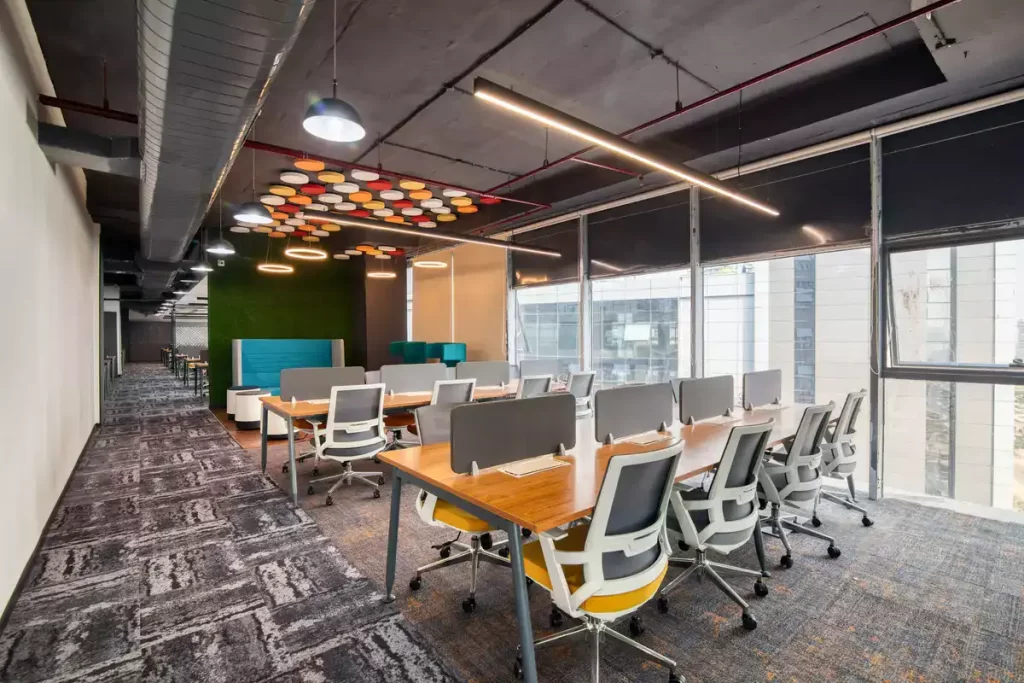
you should recognize the significance of well-designed collaborative spaces in the modern workplace.
These areas are more than just trendy additions; they are essential for fostering creativity, teamwork, and the exchange of ideas.
Ideas for Collaborative Spaces:


Meeting Rooms: Design versatile meeting rooms with adjustable furniture and integrated technology.
Incorporate writable walls and acoustic panels to facilitate discussions and idea-sharing.
Lounge Areas: Create comfortable lounge spaces with a variety of seating options, from sofas to bean bags.
Offer a mix of natural and artificial lighting to cater to different needs and moods.
Breakout Spaces: Design breakout areas that encourage impromptu gatherings and quick discussions.
Use flexible furniture arrangements to accommodate different group sizes.
Furniture and Design Elements for Collaboration:

Flexible Furniture: Invest in furniture that can be easily reconfigured to adapt to various meeting styles and group sizes.
Modular seating and movable tables provide versatility.
Collaboration Tools: Incorporate technology like interactive displays, whiteboards, and video conferencing capabilities to support collaboration in meeting rooms.
Acoustics: Pay attention to acoustics to ensure that collaborative spaces offer a degree of privacy and minimize noise disturbances.
Use sound-absorbing materials and strategic layouts.
By focusing on the importance of collaborative spaces and integrating thoughtful design elements, you can transform an ordinary office into a dynamic and innovative workspace that encourages teamwork, creativity, and productivity.
VIII. Budgeting and Cost Considerations

Budgeting is a critical aspect of any office interior design project, and careful planning can ensure that you achieve your vision without breaking the bank.
Here are valuable insights for effective budgeting and cost-conscious strategies:
Budgeting Tips:
Define Clear Objectives: Start by outlining your project’s goals, needs, and priorities.
Clearly defining your objectives will help allocate your budget to the most critical areas.
Itemized Costs: Create a detailed itemized budget that accounts for every aspect of the project, from furniture and décor to construction and installation costs.
Cost-Saving Strategies:
Prioritize Essentials: Identify must-have items that align with your project’s objectives and brand image, and allocate a significant portion of your budget to these essentials.
Re-purpose and Refurbish: Consider re-purposing existing furniture and decor elements, or invest in refurbished items, which can offer quality at a lower cost.
Strategic Design: Opt for a strategic design that minimizes the need for costly structural changes.
Effective space planning can make the most of your existing layout.
Competitive Bidding: Seek competitive bids from contractors and suppliers. Multiple quotes can help you secure the best value for your project.
Long-Term Sustainability: Invest in durable, high-quality items that may have a higher upfront cost but provide long-term savings through their lifespan.
Setting Priorities:

Flexibility: Be prepared to adapt as the project progresses.
Reevaluating priorities as you go can help you make the most of your available budget.
Communication: Maintain open and ongoing communication with your design and construction team to ensure that everyone is aligned with your budget constraints.
By carefully managing your budget and implementing cost-saving strategies, you can realize your office interior design project without compromising on quality.
Prioritizing key elements and staying flexible during the process will help you create an inspiring and efficient workspace that meets your financial goals.
IX. Maintenance and Adaptability
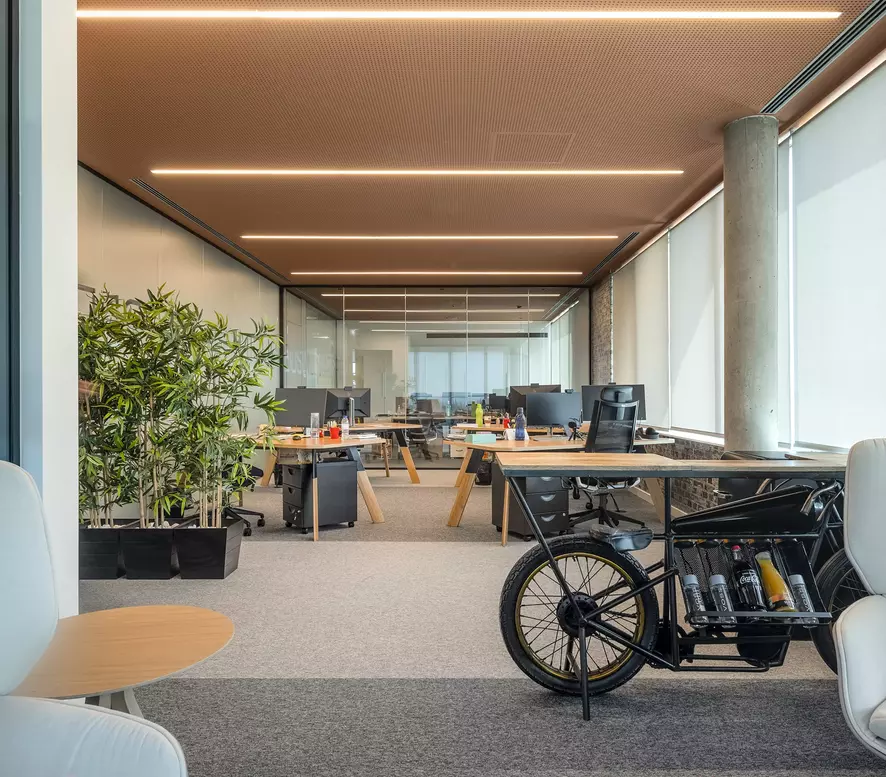
Ongoing maintenance and adaptability are essential considerations in office interior design.
To ensure your workspace remains functional and in sync with evolving needs, here are key insights:
Ongoing Maintenance:
Regular Updates: Regularly assess your office design and make necessary updates to keep it fresh and functional.
This might include refurbishing furniture, repainting walls, or upgrading technology.
Health and Safety: Ensure that maintenance also covers health and safety aspects, including fire safety systems, ergonomic furniture, and ventilation.
Adaptability to Changing Needs:
Flexible Layouts: Design spaces with flexibility in mind, allowing for easy reconfiguration as team sizes and functions change.
Modular furniture and movable partitions are great assets.
Technology Integration: Stay adaptable by integrating technology that can be updated and scaled easily as your office’s tech needs evolve.
Evolving Workstyles: As remote work and hybrid workstyles become more prevalent, adapt your office to accommodate different working preferences and needs.
Updating Office Design:
Staying Current: Keep an eye on design trends and technological advancements.
Incorporate design elements that remain relevant to your brand and the changing expectations of your workforce.
User Feedback: Encourage feedback from employees to understand how the office design can better serve their evolving needs and preferences.
Maintaining and adapting your office space are investments that pay off in employee satisfaction, productivity, and the ability to remain competitive in a changing business landscape.
X. Case Studies of Successful Office Interior Design Projects
Let’s delve into two real-world examples of our successful office interior design projects that showcase the diversity of design possibilities and their impact on the workplace environment:
Case Study 1: Functional Room Division with Modern Simplicity
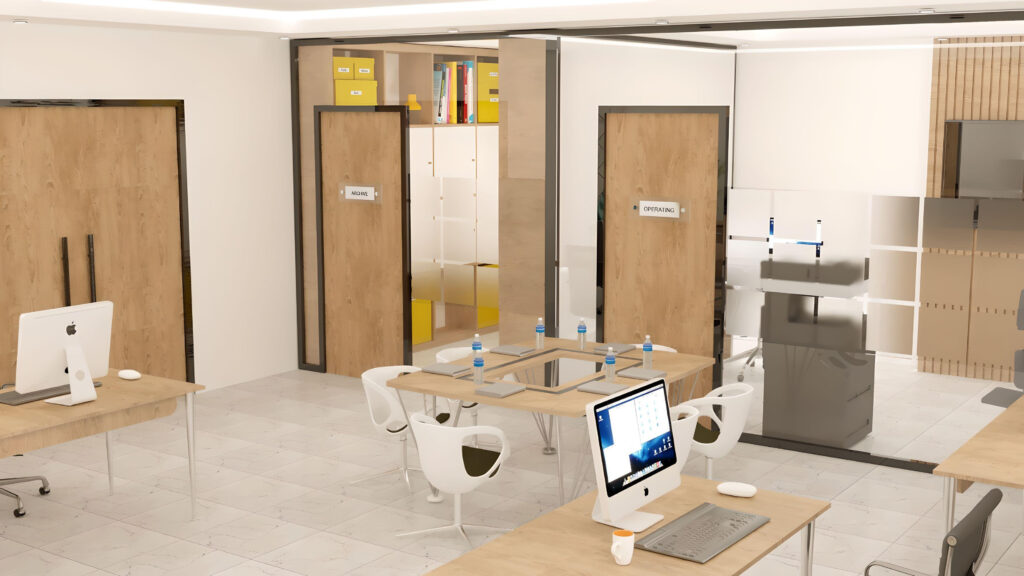
In this project, the office space was divided into separate rooms tailored to the nature of the work, providing employees with focused environments for enhanced productivity.
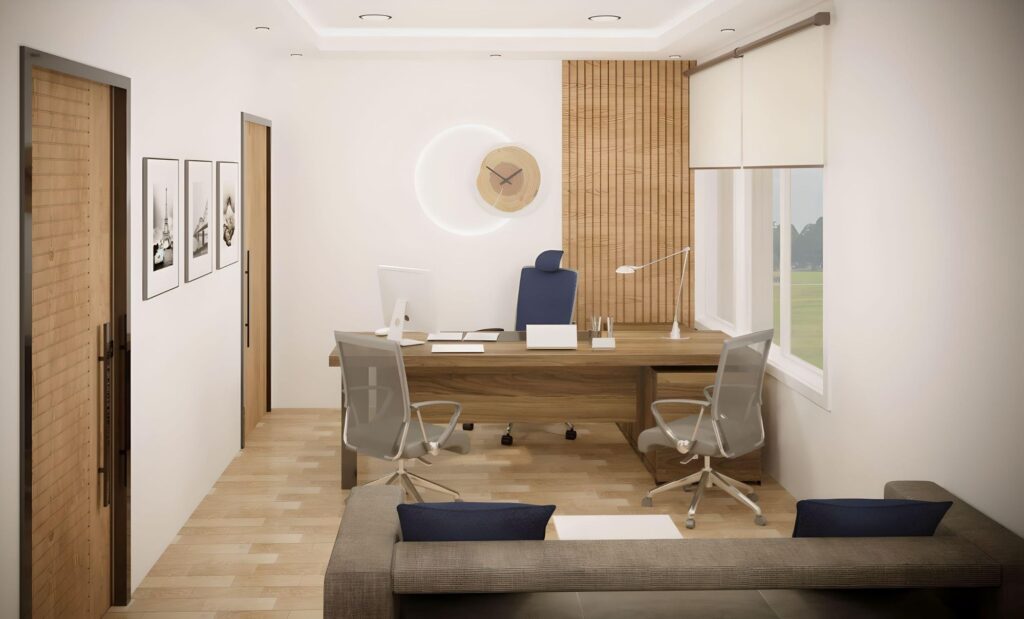
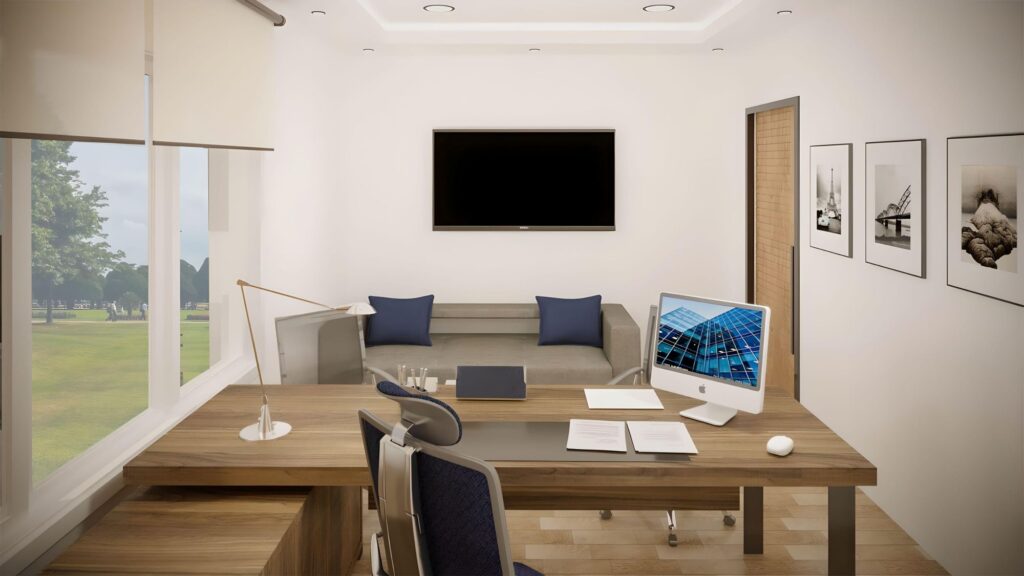

The design embraced a clean and simple modern aesthetic, featuring minimalistic furniture and a neutral color palette.
Each room was strategically laid out, with ergonomic furniture that supported the specific tasks carried out within.

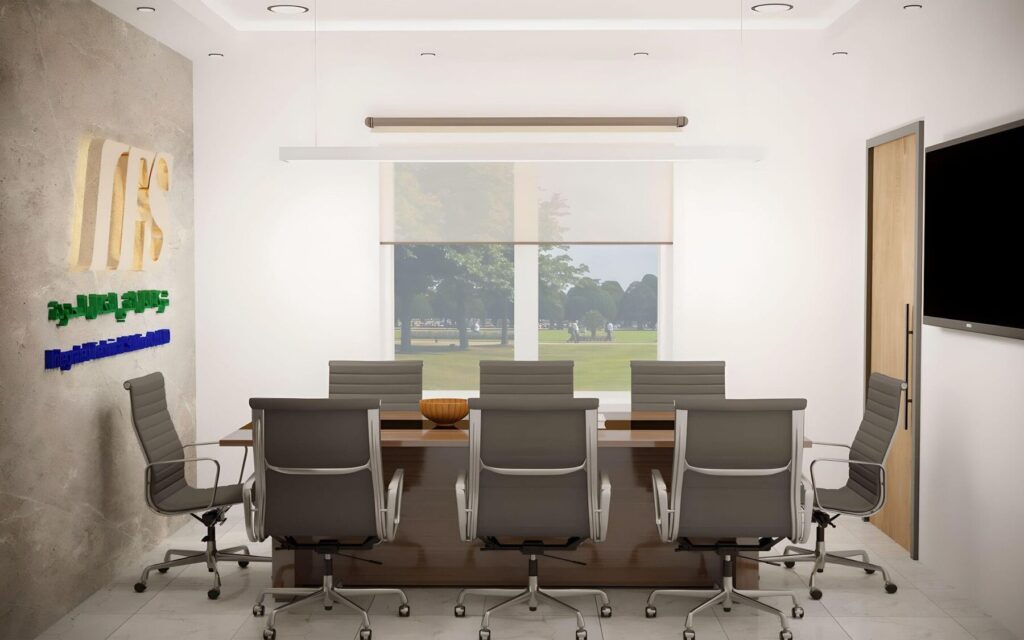

The result was a workspace that promoted concentration and efficient workflow while exuding a sense of contemporary elegance.
Case Study 2: Semi-Divided Workspace with a Modern Industrial Flair

For this project, the design blended open workstations with closed rooms to accommodate various needs within the office.


The open spaces encouraged collaboration and creativity among team members, while the closed rooms served as private offices for managers and select employees.


The design followed a modern industrial style, incorporating elements like steel accents, and large, airy windows.

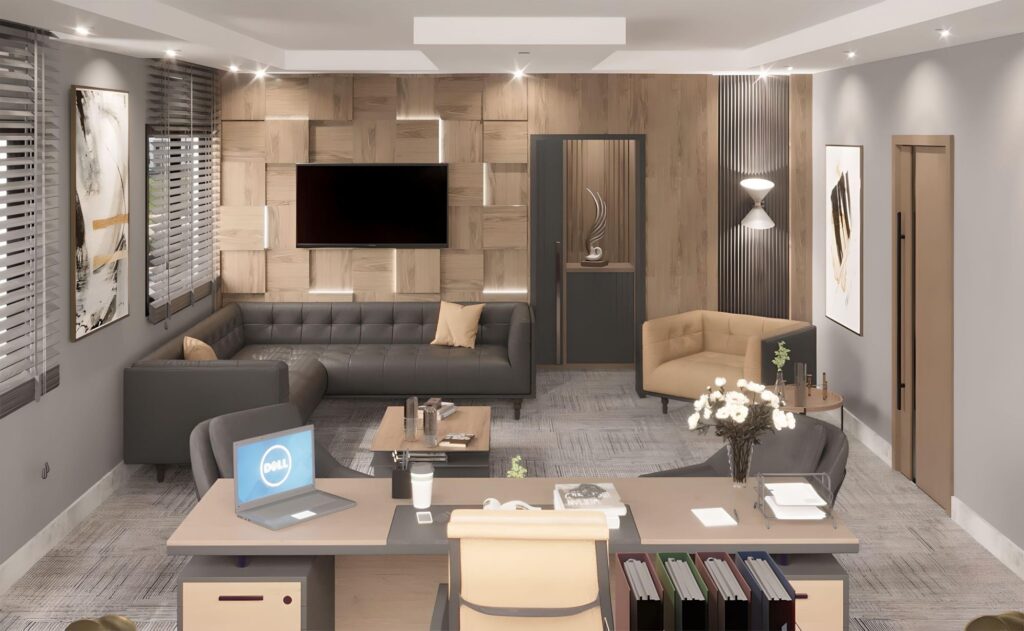
The combination of open and private spaces created a dynamic work environment that reflected the company’s culture of innovation and flexibility.
These case studies illustrate how office interior design can be tailored to meet the specific requirements and preferences of different organizations.
In conclusion, the success of your office interior design hinges on a delicate balance of form and function.
A well-designed office space can transform your work environment, fostering creativity, productivity, and employee satisfaction.
If you’re seeking to revitalize your workspace, we encourage you to contact us and explore our professional interior design services.
The potential benefits of a thoughtfully designed office space are limitless, and we’re here to help you unlock them.
